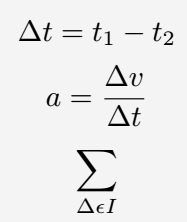| Symbol/Unicode | Big Delta/U+0394 |
|---|---|
| Type of symbol | Greek capital letter |
| Package (requirement) | No |
| Argument | No |
| Latex command | \Delta |
| Example | \Delta → Δ |
You can use LaTeX’s default command \Delta to print the big Delta symbol in a LaTeX document.
\documentclass{article}
\begin{document}
\[\Delta t = t_1 - t_2 \]
\[ a = \frac{\Delta v}{\Delta t} \]
\[ \sum\limits_{\Delta \epsilon I} \]
\end{document}Output :

varDelta(𝛥) in LaTeX
You will need the amsmath package to print the varDelta symbol to a latex document. You can print this symbol in the document with the \varDelta command included in this package.
Here you can see that there is a slight difference between the output of the \Delta and \varDelta commands.
\documentclass{article}
\usepackage{amsmath}
\begin{document}
\[ \verb|\Delta|\rightarrow \Delta \quad \verb|\varDelta|\rightarrow \varDelta \]
\[ c = \varDelta c = 2\pi(r + r\varDelta)\]
\[ \verDelta r= \frac{\varDelta}{2\pi} \]
\end{document}Output :

Bold Delta and varDelta symbol
You can use LaTeX’s default command \mathbf to bold the delta symbol, or you can use the \bm command from the bm package.
But the varDelta symbol cannot be bolded by the \mathbf command, so you have to use the \bm command of the bm package.
\documentclass{article}
\usepackage{amsmath}
\usepackage{bm}
\begin{document}
\[\verb|{\Delta}|\rightarrow \Delta \quad \verb|\varDelta|\rightarrow \varDelta \]
\[ \verb|\mathbf{\Delta}|\rightarrow \mathbf{\Delta} \quad \verb|\bm{\Delta}|\rightarrow \bm{\Delta} \]
\[ \verb|\mathbf{\varDelta}|\rightarrow \mathbf{\varDelta} \quad \verb|\bm{\varDelta}|\rightarrow \bm{\varDelta} \]
\end{document}Output :
